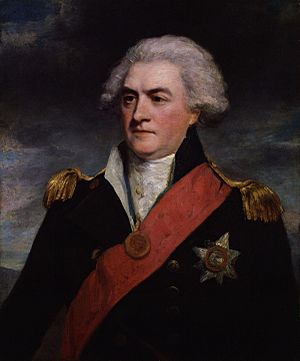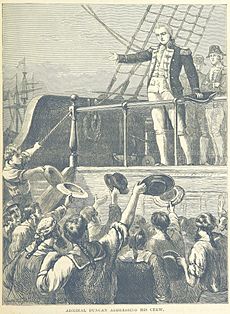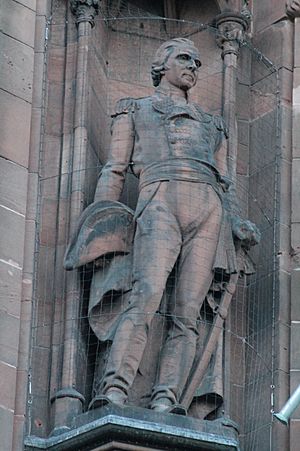Adam Duncan, 1st Viscount Duncan facts for kids
Quick facts for kids
The Viscount Duncan
|
|
|---|---|
 |
|
| Born | 1 July 1731 Dundee, Angus, Scotland |
| Died | 4 August 1804 (aged 73) Cornhill-on-Tweed, Northumberland, United Kingdom |
| Allegiance | |
| Service/ |
|
| Years of service | 1746–1804 |
| Rank | Admiral |
| Battles/wars | |
| Awards | Naval Gold Medal |
Adam Duncan, 1st Viscount Duncan (born July 1, 1731 – died August 4, 1804) was a famous British admiral. He is best known for his huge victory against the Dutch fleet. This happened at the Battle of Camperdown on October 11, 1797. His win is seen as one of the most important battles in naval history.
Contents
Life of Admiral Duncan
Adam Duncan was born in Dundee, Scotland. He was the second son of Alexander Duncan, who was a local leader. In 1746, when he was 15, Adam joined the Royal Navy. He started his career on a small ship called Trial. He served under Captain Robert Haldane. After a few years, he became a lieutenant in 1755.
Duncan continued to serve in the navy. He worked with important officers like Augustus Keppel. He gained experience on different ships. This included HMS Centurion and HMS Norwich. These early years helped him learn a lot about naval life.
Serving in the Seven Years' War
The Seven Years' War was a big global conflict. Duncan played a part in several key events.
Key Battles and Expeditions
- Raid on Rochefort: In 1757, he was part of an attack on Basque Roads.
- Capture of Gorée: In 1758, he helped capture Gorée, an island off Africa.
- Blockade of Brest: He also took part in blocking the French port of Brest.
In 1759, he was promoted to commander. He then briefly commanded a hired ship called Royal Exchange. Later, in 1761, he became a captain. He served on HMS Valiant. With this ship, he helped capture Belle Île in 1761. He also helped take Havana in 1762. After these victories, he returned to Britain in 1763. He did not get another command for many years.
Peacetime and New Commands
During this long break, Duncan lived mostly in Dundee. In 1777, he married Henrietta Dundas. Her family was quite influential. This connection may have helped him get back into service.
Return to Active Duty
In late 1778, he was given command of HMS Suffolk. Soon after, he moved to HMS Monarch.
Court-Martial Duty
In 1779, Duncan was part of a court-martial for Admiral Keppel. A court-martial is like a military trial. Keppel was accused of poor performance in a battle. Duncan spoke up several times during the trial. He wanted to stop unfair questions. The navy leaders did not want him on another similar trial. But because of a delay, he ended up serving on that one too.
Service in the American Revolutionary War
Monarch joined the Channel fleet in 1779. In December, Duncan sailed with Admiral Rodney. They went to help Gibraltar during a siege. Duncan played a big role in the battle off St. Vincent in January 1780. After this, he had no command until 1782.
He then commanded HMS Blenheim. He served under Admiral Howe. They helped Gibraltar again in October 1782. They also fought the enemy fleet off Cape Spartel. After the war, he commanded HMS Edgar for three years. He became a vice admiral in 1793. By 1795, he was a full Admiral. In February 1795, he took charge of the North Sea fleet. His main ship was HMS Venerable.
Victory Against the Dutch Fleet
For two years, Duncan's job was to block the enemy's coast. But in 1797, things became more serious. The Dutch fleet was preparing to sail.
Facing the Mutiny
The British fleet faced a big problem. Many sailors refused to obey orders. This was called a mutiny. It affected Duncan's fleet too. For weeks, he could not act. But Duncan's strong personality helped. He convinced his crew on Venerable to stay loyal. Only his ship and Adamant remained on duty. They pretended to keep the blockade going. Luckily, the Dutch were not ready to sail yet.
The Battle of Camperdown
The Dutch fleet finally set sail in October. Duncan was at Great Yarmouth getting supplies. He quickly learned the Dutch were at sea. He sailed towards them. On October 11, he saw the Dutch fleet near Camperdown. The wind was blowing towards the shore. Duncan knew he had to act fast. He needed to get between the Dutch ships and the land. This would stop them from escaping into shallow waters.
Duncan made a bold decision. He did not wait for his ships to form a perfect line. He ordered his fleet to break through the enemy's line. This was a new tactic. It worked perfectly. The battle was long and fierce. Both sides fought hard. But Duncan's well-trained gun crews won the day. The British navy showed it was still strong.
Rewards for His Victory
The news of Duncan's victory made everyone in Britain very happy. It proved the navy was still powerful after the mutinies.
Titles and Honors
- Viscount Duncan: On October 21, 1797, he was made Viscount Duncan. He also became Baron Duncan.
- Pension: He received a yearly pension of £3,000. This was one of the largest pensions ever given by the British government.
- Medals and Freedoms: He was given the Naval Gold Medal. He also received the freedom of several cities, like Dundee and London.
Years later, in 1831, his son was made an earl. This showed how important Duncan's victory was.
Death and Legacy
Duncan continued to command the North Sea fleet until 1801. He died suddenly on August 4, 1804. He was 73 years old. He passed away at an inn in Cornhill-on-Tweed while traveling. He was buried in Lundie, west of Dundee.
Memorials and Tributes
- St Paul's Cathedral: There is a memorial to him in St Paul's Cathedral in London.
- Statues: A statue of Duncan was put up in his hometown of Dundee in 1997.
- HMS Duncan: Several navy ships have been named HMS Duncan in his honor.
- Places Named After Him: Places like Duncan Terrace in London and Duncan Street in Leeds are named after him. Even Pinzón Island in the Galapagos was once called Duncan Island.
His Character and Family
Duncan was a very tall and strong man. He was about 6 feet 4 inches (1.93 meters) tall. People described him as very handsome.
Nelson's Respect
Even Admiral Nelson, another famous British admiral, admired Duncan. Nelson wrote to Duncan's son after Duncan's death. He said, "The name of Duncan will never be forgot by Britain, and in particular by its navy."
Family Life
Duncan married Henrietta Dundas in 1777. They had four daughters and two sons. His oldest son inherited his title. His second son, Henry, also became a navy captain. Duncan's sister Margaret was the mother of James Haldane Tait. James also served under Duncan and became a Rear Admiral.
Heraldry and Symbols
Admiral Duncan's family had a special coat of arms. After his great victory, he was given an extra symbol of honor. This symbol showed Victory crowning Britannia. It also had the word "Camperdown" on it.
Meaning of His Symbols
- Crest: His crest showed a damaged warship. This symbolized his tough battles.
- Mottoes: He had two mottoes. "Disce Pati" means "learn to suffer." "Secundis Dubiisque Rectus" means "Upright in prosperity and in doubt." These showed his strong character.

Images for kids
-
Adam Duncan by Richard Westmacott in the crypt of St. Paul's Cathedral








